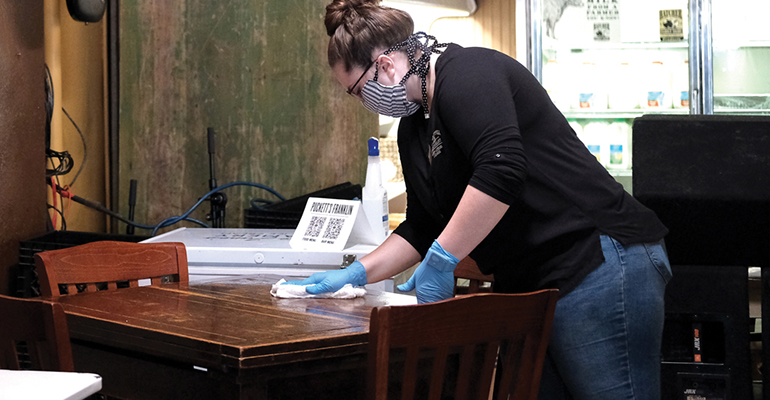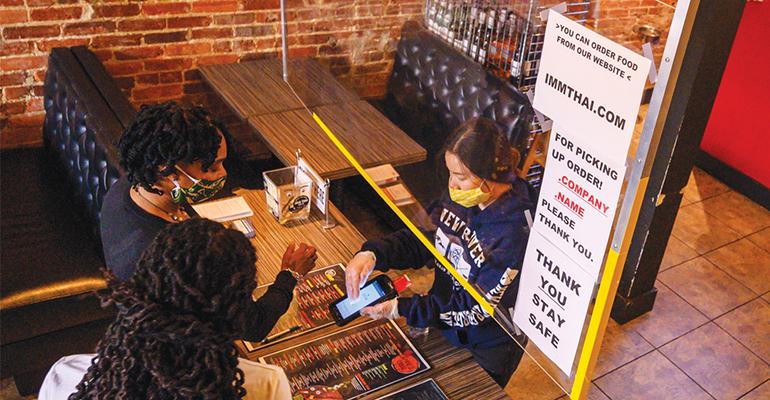As restaurants reopen or rev up their operations after coronavirus restrictions, operators face a multitude of workforce challenges and a number of potential thorny legal issues.
And workers themselves are nervous.
More than half, or 54%, of U.S. workers were worried about being exposed to the novel coronavirus, or COVID-19, according to a national poll in April by Arlington, Va.-based Eagle Hill Consulting LLC. And 43% of U.S. workers supported employers testing for symptoms.
Operators expressed confidence they could retain workers if they were able to keep from laying off or furloughing them.
Andy Howard, president and CEO of Orlando, Fla.-based Huey Magoo’s, said his restaurants in early May had brought sales back to near pre-coronavirus levels and had not had to cut staff positions.
“We’ve cut back on hours a little bit,” Howard said. “All of the corporate staff remained.”
Howard said the 12-unit quick-service chicken brand two weeks into the pandemic gave every employee in the system $100.
“We just wanted to show we cared,” Howard said. “It was a little hey-go-buy-groceries-for-your-family thing.” The company sent a note to franchises to get $100 bills, so “every store gave every employee a crisp $100 bill.”
 Howard said Huey Magoo’s did qualify for a Paycheck Protection Program loan, which helped the company.
Howard said Huey Magoo’s did qualify for a Paycheck Protection Program loan, which helped the company.
“Unfortunately, I think the workforce is going to be [easy] pickins for those of us still around,” Howard said in a phone interview. More than 30 million U.S. workers have made first-time claims for unemployment in the past six weeks.
Kent Taylor, founder and CEO of Louisville, Ky.-based Texas Roadhouse Inc., said the company had shifted to off-premise sales to keep its casual-dining units open and workers employed during restrictions. About 125 of its 610 restaurants, which include the Bubba’s 33 brand, were reopening dining rooms in early May, but with limited capacity.
Tonya Robinson, Texas Roadhouse chief financial officer, said restaurant operators were staying in touch with their employees and “they’re eager to come back to work.”
Eagle Hill’s survey found that, in management for a post-lockdown world, employees expressed a desire for: transparency and open communication from leadership (44%), remote work flexibility (42%) and employee wellness efforts (41%).
“In the coming weeks, employers and workers will encounter perhaps the most significant and rapid changes to the workplace we have ever encountered in modern history,” said Melissa Jezior, president and CEO of Eagle Hill.
“Change management is a steep struggle for most employers — and implementing such massive modifications to how we work will not be easy,” Jezior said.
“The No. 1 focus of employers right now should be employee engagement,” she said. “That means understanding, at the most granular level, employee sentiment about COVID-19, their challenges in returning to the workplace, and how to keep the workforce safe — and then taking action to address employee feedback.”
 Seven lawyers from the Davis Wright Tremaine firm, which specializes in employment law, in early May addressed legal issues that executives may face as they reopen workplaces, ranging from providing a safe and compliant work environment to the potential for harassment and retaliation claims should someone be fearful of returning to a workplace.
Seven lawyers from the Davis Wright Tremaine firm, which specializes in employment law, in early May addressed legal issues that executives may face as they reopen workplaces, ranging from providing a safe and compliant work environment to the potential for harassment and retaliation claims should someone be fearful of returning to a workplace.
Michael Killeen, a DWT partner in Seattle and moderator of the lawyer panel, said workplace issues have changed quickly. “Two months ago seems like a far and distant place from where we are now.”
Here are six issues businesses will be facing.
Workplace environment
A safe and compliant work environment in the age of novel coronavirus “is a moving target,” said Joseph Hoag, a lawyer in the Seattle office of DWT. New guidance and changes in existing guidance are being issued by agencies frequently.
The Centers for Disease Control and Prevention guidelines, on which many employers base their own rules, has been changing, recently expanding symptoms for COVID-19 — such as dry cough and fever — and in early May revised to test for home quarantine of those with suspected coronavirus cases, Hoag said.
“If you are relying on symptoms the CDC has identified, you need to keep up and make sure you are changing your policies,” Hoag said.
Protective barriers, such as plastic screens, could become part of workplace safety protections, Hoag said, and they are becoming more widespread. Some employers have installed barriers in restrooms between urinals, he noted. Some jurisdictions require different levels of personal protective equipment, or PPE, such as face masks and gloves, so operators should stay aware of those rules, he said.

“If you are relying on symptoms the CDC has identified, you need to keep up and make sure you are changing your policies,” Joseph Hoag said.
Many operators are checking onsite temperatures of employees at the beginning of shifts or screening about coronavirus symptoms, but that poses privacy-rights issues, Hoag said, and that information must be kept confidential.
“Any medical information you get about your employees, such as questionnaires or fever information, needs to be protected and treated just as you would with any other medical information,” Hoag said. Some states, like California, require notices before temperature information is collected.
Return to work protocols
Standards need to be identified for those who need to return to work or to be invited back if the workplace opens on a phased program, said Michael Goettig, a DWT lawyer in South Orange, N.J.
“A good rule of thumb is to involve the employee in the process,” Goettig said.
Older workers, especially those 65 and older, have been identified by the CDC as especially at risk in the coronavirus pandemic, and the agency issued new guidance May 5 on underlying physical issues on the threat to health for those workers. Those are similar to any other American with Disabilities Act issues, he said.
“Although the ADA does not interfere with ADA-compliant measures to exclude from the workplace employees who are potentially contagious with COVID-19, that is because such measures are justified by a direct threat to others due to the risk of transmitting COVID-19,” Goettig said in response to a question. “By contrast, only a determination of direct threat to self (i.e., to his own health) justifies exclusion from the workplace of an employee because he has a preexisting, underlying condition that places him at higher risk for severe illness from COVID-19.”
A “concrete to-do item for employers as they put their plan together,” Goettig said, is they should post a Families First Coronavirus Response Act poster, available at the Department of Labor website, and other information for workers.
Jason Kempin/Getty Images
Older workers, especially those 65 and older, have been identified by the CDC as especially at risk in the coronavirus pandemic, and the agency issued new guidance May 5 on underlying physical issues on the threat to health for those workers.

Older workers, especially those 65 and older, have been identified by the CDC as especially at risk in the coronavirus pandemic, and the agency issued new guidance May 5 on underlying physical issues on the threat to health for those workers.
Paid time off and sick leave
A patchwork of state and laws exist for paid time off and sick leave for medical issues or to care for family members, including quarantine and isolation, said Angela Vogel, DWT counsel in Bellevue, Wash.
“While this crisis has been unfolding, some of these rules and ordinances related to the sick pay plan have been changing,” said Vogel. “For instance, the city of Seattle amended their law in March and also have an emergency rule in place temporarily. Be sure you are staying up to date on these laws.”
Benefits timetables
“Among all the other things you are concerned about when people come back to work,” said Jeff Belfiglio, a partner at DWT, “is getting back on the employee benefits plans.”
Much will depend on whether employees were on unpaid furlough and never terminated versus laid off and rehired, he said.
 “As you can expect, a lot of people coming back will have reassessed their financial condition and probably want to make new elections to 401(k) deferrals for the rest of the year,” Belfiglio noted. It is more complicated for healthcare plans, he said, with some employers maintaining the coverage during furlough but may want to waive any waiting period.
“As you can expect, a lot of people coming back will have reassessed their financial condition and probably want to make new elections to 401(k) deferrals for the rest of the year,” Belfiglio noted. It is more complicated for healthcare plans, he said, with some employers maintaining the coverage during furlough but may want to waive any waiting period.
Insurance policies will often outline the terms, he said.
Staffing decisions
If employers have to make layoff decisions, Laura Heckathorn, a DWT counsel in Las Angeles, warned that protected groups — such as age and race — should be considered.
“A release or severance program is one way to reduce risk generally,” she said, “however, it is important to remember there is a waiting period, so to speak, for releases under federal law.”
Additional layoffs or furloughs could be provided through a volunteer exit program, she said.
Company culture
Workforce-based lawsuits, especially those around harassment and retaliation, are oftentimes “morality plays,” said Emilio Gonzalez, partner in DWT’s Los Angeles office, who called them a battle of competing narratives in which the employer is cast as the villain — greedy, callous and unfair.
The employer can’t say “that’s not true” or “that’s not why,” he said, but the choices should be portrayed as “thoughtful, caring and fair.”
“This pandemic is an opportunity to highlight the best of your company culture,” Gonzalez said, especially for how individual managers communicate with the people they manage.
“In the same way people quit managers not companies,” he said, “people tend to sue when they feel they have been mismanaged or treated unfairly.”
Contact Ron Ruggless at [email protected]
Follow him on Twitter: @RonRuggless

